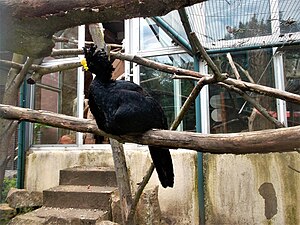Tubercle hokko
| Tubercle hokko | ||||||||||
|---|---|---|---|---|---|---|---|---|---|---|

male tubercle hokko |
||||||||||
| Systematics | ||||||||||
|
||||||||||
| Scientific name | ||||||||||
| Crax rubra | ||||||||||
| Linnaeus , 1758 |
The Tuberkelhokko ( Crax rubra ) is a 90 to 100 centimeter large chicken from the family of the Hokkohühner .
Appearance
The coloring of the sexes of this species is very different from each other. The male has an almost completely black body plumage, only the belly is white. The bulging wax skin on the beak and the beak itself are yellow. The long legs and tail are also black. The female is mostly brown, there are also very red, pink, black or two-tone morphology of the plumage known. The female is slightly smaller than the male. The neck is speckled gray and white like the hair on the black and white head. The female's tail is speckled white, black, and brown. The back toe is much longer than that of other chicken and enables a better grip in the branches of the trees.
distribution and habitat
This species occurs in the primeval forests from Mexico to western Ecuador and western Colombia . There the Tuberkelhokko inhabits the dense primeval forests.
Way of life
The tubercle hokko spend most of the day foraging for food. It eats fresh plant shoots, fruits, seeds, nuts and occasionally insects and smaller vertebrates such as geckos and iguanas . In order to digest the hard plant food better, they swallow smaller stones. They are sociable animals and roam the forest in pairs or in small groups in search of food. Are very scary animals. He spends the night in the branches of tall trees. Birds of prey are among their natural enemies . Life expectancy is approx. 12 years.
Courtship
The male's singing is a long, low roar, amplified by her long windpipe. This is used by the male to attract the females for mating and to deter male rivals.
Reproduction
The Tuberkelhokko builds the flat, well-camouflaged nest of leaves and twigs in the trees at a height of 6–30 meters above the ground. He mostly uses abandoned clumps of birds of prey as a foundation. The female lays 2–4 matt-white, rough, uneven eggs in the nest. The eggs are the size of a goose egg. The breeding business is done by the female alone. The young hatch after 25–29 days. As soon as the youngsters' plumage has dried, they jump down to the ground in front of the nest. For the next few days hide from enemies in the thick undergrowth. Both adult birds take care of the young together. At the age of 4 days, the boys make their first attempts to fly. At one week old, they follow the female to her roost. At the age of 4 weeks, the boys leave their parents and go their own way.
use
The natives of the area hunt the birds for their meat and collect the eggs for consumption. Occasionally the young birds are also kept together with the domestic fowl because they become tame very easily.
Danger
The IUCN classifies this species as ( Vulnerable ) endangered. The reasons for this are poaching , habitat destruction through logging , hurricanes and the introduction of foreign animal species. To protect the species protected areas in their natural habitat, such as the Santa Rosa National Park , Rincón de la Vieja Volcano National Park , Corcovado National Park on the Nicoya Peninsula in Costa Rica reported. In Belize this species enjoys a year-round closed season . It is also listed in Appendix III of the Washington Convention on the Protection of Species and is subject to trade and export restrictions in the countries of origin.
literature
- Wildlife of America in color Page: 39.40 Karl Müller Verlag Erlangen 1989
- The great encyclopedia of birds Page: 110, 112 Orbis Verlag 1996 ISBN 3-572-00810-7
- The great world empire of the animals Page: 226,227 Planet Medien AG Zug 1997 ISBN 3-8247-8614-1
- Fascination of the animal world Page: 180 New Honos Verlag Cologne 2000 ISBN 978-3829904780
- Fascinating Bird World Page: 66.67 Karl Müller Verlag 1992 ISBN 3-86070-320-X
- THE BLV Encyclopedia Birds of the World Page: 196,197 BLV Buchverlag GmbH & Co. KG Munich 2004 ISBN 3-405-16682-9
Web links
- Crax rubra inthe IUCN Red List of Threatened Species 2019.2. Listed by: BirdLife International, 2016. Retrieved August 19, 2019.


